General Information

Mexican Free-tailed bat found on school campus
Bats are highly beneficial wild mammals. Some bat species eat their weight in insects each night. Others are important pollinators. Bats are not flying rodents, but belong to a unique order of mammals called Chiroptera (Latin for “hand wing”). A common myth about bats is they are blind. Bats have good vision; however, they can also use sound waves (echolocation) to help them navigate and locate food.
Because bats are mammals, they give birth to live young. Most produce one pup a year, although a few species give birth to litters of two to four pups. Some bat species mate in the fall or winter, but fertilization is delayed and development of the fetus does not occur until spring. Other species, such as the Mexican free-tailed bat, mate in the spring. Fertilization and fetal development follow, and pups are generally born in the spring or early summer (mid-April to June). By late summer, the pups are able to fly and feed on their own.
Bats live in a variety of places including caves, abandoned mines, hollow trees, under tree bark, in palm fronds and in crevices under bridges. As natural habitats decrease, some species commonly roost in buildings. Bats are creatures of habit and will return to the same roost year after year. Unfortunately, in the South, some bat species have found this area habitable all year long although their migration patterns may require them moving from one part of the state to another. Often during cool weather, if bats are roosting inside a structure, they will move farther into the structure to stay warm.
Direct contact with a bat may result in potential rabies exposure, so all bats that come in direct contact with students, faculty or staff must be tested for rabies. Direct contact means being bitten by a bat or getting bat saliva or brains into your eyes, nose, or mouth. According to the Centers for Disease Control and Prevention (CDC), recent data suggest that transmission of the rabies virus can occur from minor, seemingly unimportant, or unrecognized bites from bats.
Assume a person was bitten if:
- He/she awakens to find a bat in the room;
- A bat is found in the room with someone unable to communicate well (i.e. children, intoxicated or otherwise mentally impaired);
- The bat made contact with a person.
Identification
Many species of bats are protected by state and federal laws. It is important to follow all laws to protect these beneficial animals. If possible, identify the species before attempting to remove bats from a building. Some bats are easy to identify but others require training and the use of identification keys. Knowing the bat species will help in managing bats; some species of bats are migratory. Ask someone from the state wildlife agency or Bat Conservation International to determine which species of bats live in your school district.
The most common species of bats that schools typically encounter that can also carry rabies are:
| Species | Recognition | Important biological information | Image |
| Big Brown Bat
Eptesicus fuscus |
|
|
 |
| Mexican free-tailed bat
Tadarida brasiliensis |
|
|
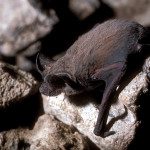
|
| Hoary Bat Lasiurus cinereus |
|
|
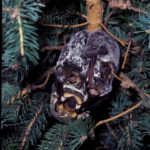
|
| Eastern Red Bat Lasiurus borealis |
|
|
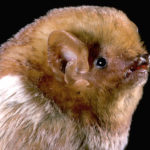
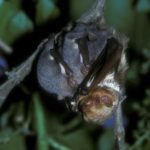 L borealis typically give birth to twins |
Suggested Thresholds
- Classroom, gym or interior of building: One bat found on floor or inside structure
- Building (artificial roosts): Seeing bat droppings or a bat colony inside building.
- See Identifying Bat Droppings to distinguish bat droppings from rodent droppings.
Monitoring and Inspection
The first step in bat management is to find bat entry points in and around buildings.
- Inspections should be conducted 1/2 hour before sunset or sunrise and look for bats entering or exiting the building. (Don’t inspect during rain, strong winds or temperatures less than 50 degrees F.)
- During cooler months, this step may need to be repeated several nights in a row to establish exit and entry points because bats do not leave the roost at night if temperatures are too cold. This step is extremely important in identifying where to place bat eviction tubes and nets. Bats normally enter near the top of structures.
- Unlike rodents, bats are not generally capable of chewing openings and must use existing holes. An opening the size of your thumb is enough for a small bat to squeeze through, but buildings with well-established roosts will probably have larger openings.
During an initial inspection, it should be determined whether any person or pet has been bitten or otherwise had direct contact with a bat. If this has occurred, the local health department should be contacted and the bat should be tested for rabies if the specimen is available. If possible, species identification should be done to aid in determining colony roosting behavior. If the species is known to roost in large numbers, colonies can have multiple access points into a structure, which makes eviction harder.
Nonchemical Control Measures
If you find a bat on school property, have the following items available before you approach the bat: a pair of thick work gloves, a plastic face shield, a small cardboard box, and masking or duct tape. After putting on the gloves and face shield, carefully place the box over the bat. Place a sturdy piece of cardboard under the box, secure the container and tape it shut. Bats should be released ONLY after you make sure no person or pet had direct contact with the bat. Take the bat outside and place it on a high surface or close to a tree so the bat can crawl up. Although bats are the only mammal known for its true flight, they generally cannot take off from the ground. They must be 6 feet above the ground to allow enough air movement under their wings for flight.
Bats in Buildings: A Guide to Safe & Humane Exclusions developed by Bat Conservation International is the most comprehensive set of instructions to help when it comes to eviction of bats. The steps below are designed to assist the school district prevent bats when possible.
Sanitation/Cultural
Buildings vary on the degree of structural modification needed to successfully seal bat entry points. Often, spot repairs with simple materials will be sufficient. In some cases, part of the structure (such as the roof) may need to be rebuilt.
Physical/Mechanical
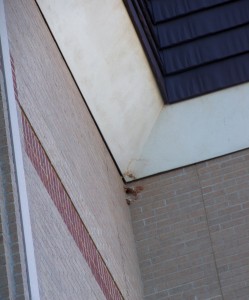
Entry point where bats were entering this school campus.
You can prevent bats from entering the human living space of a building. Any opening in the walls or roof can allow bats to enter the structure. Common sites include gaps under and over attic doors, gaps around pipes passing into the ceiling, pocket doors that slide into the walls, loose fitting baseboards and broken plaster.
Bats may be effectively evicted from a building using check valves. Check valves are devices that work like a one-way door for bats. When installed over the major entry sites, check valves allow bats to leave but not re-enter the structure.
When working to evict bats, make sure not to make the problem worse and always keep in mind bat conservation. All work should be started before the young are born or after they are weaned and able to fly. When young are present, let adult bats fly. Never use exclusion when there are young in the roost. Consult state wildlife agencies for more precise dates on when young are present in your area. Some work has been done with combining exclusion with the use of bat houses as an alternative roosting site.
Chemical Controls
There are no chemical control options for bats. All methods require patience and understanding of bat biology and total eviction and exclusion. For large bat colonies, hiring a professional bat excluder is recommended because bat exclusion work requires the ability to work and stay on tall ladders for long hours.
Evaluation Methods
Watch and observe other areas of the building to ensure bats are not roosting in another location and to ensure exclusion was successful.


